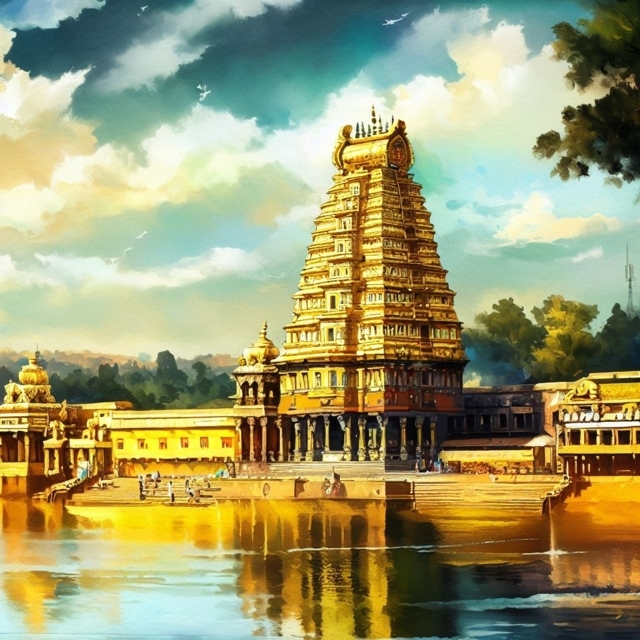Island Town That Shaped the History of Mysore Kingdom.
The Mysore Kingdom was founded in 1399 by Yaduraya in the region of the modern city of Mysore. The Wodeyar dynasty, as the ruling family is known, ruled the southern Karnataka region until Indian independence in 1947, when the kingdom was merged with the Union of India. Mysore remained the capital of the kingdom until Raja Wodeyar moved it to Srirangapatna in the upper Kaveri Valley in 1610. This strategic move was an attempt to demonstrate his power over lands that had once belonged to another kingdom. The move also provided strategic protection against military attacks. Later, the capital of Mysore was moved out of Srirangapatna to the present-day Mysore City.
Cultural Significance of Srirangapatna
The move of the capital of the Mysore Kingdom from Mysore to Srirangapatna had significant aftereffects on the kingdom. Srirangapatna is an island town located in the upper Kaveri Valley, which was once the capital of the Mysore Kingdom. The town has a rich history and cultural significance. The Ranganathaswamy Temple, located in Srirangapatna, is one of the five important pilgrimage sites of Sri Vaishnavism along the river Kaveri for devotees of Ranganatha. The temple is dedicated to the Hindu god Ranganatha, a manifestation of the god Vishnu. The temple complex is beautifully carved and surrounded by the River Kaveri, which adds to its beauty.
Art of Srirangapatna: Mysore Painting
Srirangapatna is also known for its art, particularly Mysore painting. Mysore painting is an important form of classical South Indian painting style that originated in and around the town of Mysore in Karnataka, encouraged and nurtured by the Mysore rulers. The distinct school of Mysore painting evolved from the paintings of Vijayanagar times during the reign of the Vijayanagar Kings. The most famous of the manuscripts detailing the various nuances of the Mysore school and listing out the various Gods and Goddesses is the Sritattvanidhi, a voluminous work of 1500 pages prepared under the patronage of Mummadi Krishnaraja Wodeyar. Mysore Paintings are characterized by delicate lines, intricate brush strokes, graceful delineation of figures, and the discreet use of bright vegetable colors and lustrous gold leaf.
Architecture of Srirangapatna: Daria Daulat Bagh Palace
Srirangapatna is also home to the Daria Daulat Bagh palace, built by Tippu Sultan in 1784. The palace is built in the Indo-Saracenic style and is mostly made of teakwood. The palace is set amidst beautiful gardens called Daria Daulat Bagh. The museum in the palace has the painting Storming of Srirangapattanam, an oil painting by Sir Robert Ker Porter made in 1800. This historical painting depicts the final fall of Srirangapatna on 4 May 1799.
Social Life of Srirangapatna: The Impact of the Move of the Capital
The move of the capital to Srirangapatna also had a significant impact on the social life of the people. During the two generations of Sultanate rule (Hyder Ali and Tipu Sultan), the town got a mosque, a fort, a palace, and a Muslim mausoleum. The town also has relics and stories from another topic belonging to another religion. The majority of tourists visit Srirangapattana to relive the story of one of India’s fiercest warriors against British colonization: The Muslim ruler Tipu Sultan.
Conclusion
In conclusion, the move of the capital of the Mysore Kingdom from Mysore to Srirangapatna had significant aftereffects on the kingdom. The town of Srirangapatna has a rich history and cultural significance, including the Ranganathaswamy Temple, Mysore painting, and the Daria Daulat Bagh palace. The move also had an impact on the social life of the people, with the town getting a mosque, a fort, a palace, and a Muslim mausoleum.
Tags
Divi Meetup 2019, San Francisco
Related Articles
Unappreciated Greatness
Life and Legacy of Jahangir of the Mughal Empire. Jahangir ruled over one of the largest empires in human history during his lifetime, yet few people outside of South Asia have heard of him. I aim to shed light on the life and legacy of this remarkable figure,...
The Plague Doctor’s Diary
A Personal Account of the Turin Epidemic of 1656. I am writing this diary to record my experiences and observations as a plague doctor in Turin, the capital of the Duchy of Savoy, during the terrible epidemic that has afflicted this city and its surroundings since the...
The Timeless Beauty of Bustan
Unveiling the Secrets of Saadi Shirazi's Masterpiece.In the realm of Persian literature, few works have captured the essence of love, spirituality, and morality quite like Bustan (The Orchard) by Saadi Shirazi. This 13th-century masterpiece has left a lasting impact...
Stay Up to Date With The Latest News & Updates
Explore
Browse your topics of interest using our keyword list.
Join Our Newsletter
Sign-up to get an overview of our recent articles handpicked by our editors.
Follow Us
Follow our social media accounts to get instant notifications about our newly published articles.









